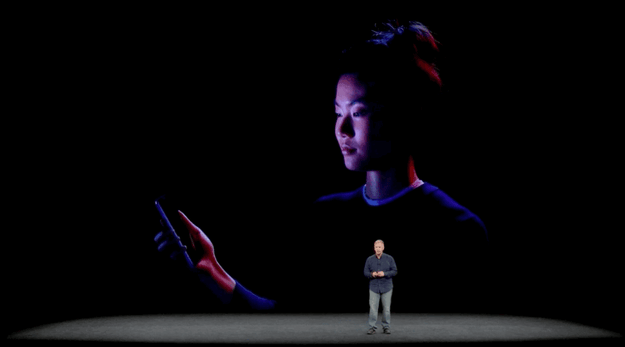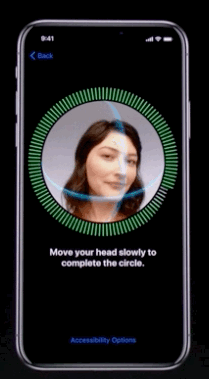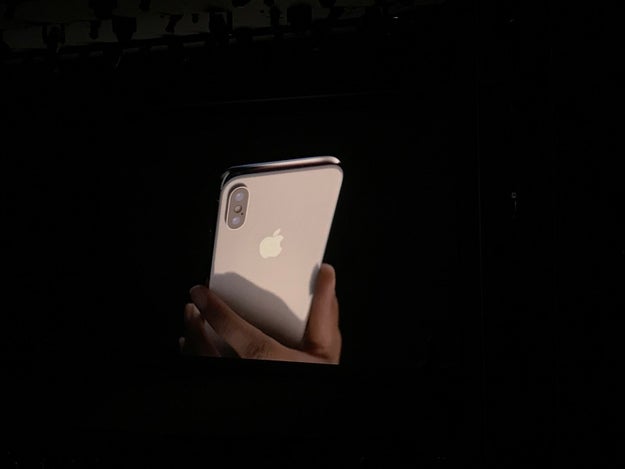
Apple
The most highly anticipated reveal was that of the new iPhone X, presumably named after the device’s tenth anniversary.
Most importantly: This model proves that, yes, iPhones can be even more expensive than they already are. The new high-end phone *starts* at $999—and, to justify that price, includes some of the biggest updates to the iPhone since 2014.
With its edge-to-edge display and buttonless face, the new iPhone looks remarkably different from iPhones past. At 5.8 inches diagonally, its screen is taller and larger than the 4.7-inch iPhone, but smaller than the larger 5.5-inch iPhone Plus. The Galaxy S8-esque screen has a hardly noticeable border around it, making all kinds of content—video, articles, apps—appear full-screen.
The display’s immersiveness is largely due to the fact that instead of a home button, there’s just more screen.
It’s an update that’s likely to be just as controversial as the removal of the headphone jack last year and the change from the 30-pin to Lightning connector in 2012.

Apple
No home button means that the way you interact with the phone will be different. Instead of tapping the button to see your homescreen, you’ll flick up from the bottom of the screen. To force restart the phone, you’ll now long press the power and volume up buttons, and to invoke Siri, you’ll double click the power button.
But the real change is the screen.
The iPhone X has an OLED screen, versus the LCD (liquid crystal display) in older models. OLED screens display darker blacks, brighter whites, and more vibrant colors, and Apple is including a number of new wallpapers to show off the display. These screens are also more power-efficient and thinner than LCD screens, because they don’t require an always-on backlight layer. Both Samsung and LG have implemented OLEDs in various devices. In fact, the new iPhone’s display is reportedly made by Samsung.
True Tone, a feature that makes the screen easier on the eyes and was originally announced for the iPad, will also be available on the iPhone X. It can detect the color temperature of the room. So, for example, if the room has warm, yellow lighting, the phone’s display will look warm, too (the same way a piece of white paper reflects the light around it).
The display has rounded screen corners (older iPhones have square corners) and completely covers the front of the device, except for a thin notch at the top, which houses the earpiece (for calls), plus a new array of cameras and sensors designed to detect your face. Your FACE. Which brings us to ….
Apple is the latest to add face-scanning tech to its phones with what it’s calling Face ID.

Apple
The new phone has a "true depth camera system" (flash and an infrared sensor for low-light detection) in the front of the device to first, validate that it is actually you who is using the phone and second, unlock your phone. Previously, the only form of biometric authentication (aka using your body’s data) on the iPhone was through Touch ID on the home button, which sensed your fingerprint.

The A11 Bionic neural engine inside of the phone powers the machine learning algorithm processing for Face ID. It can perform 600 billion operations per second, allowing it to understand your face, with a different hairstyle, glasses, at night, and during the day. Apple claims that it can't be duped by high-res photograph.
Compared to Touch ID (which fails 1 in 50,000 times), Face ID fails 1 in 1,000,000. That's the chance that a random person can unlock your phone. It can work with Apple Pay, and all apps that work with Touch ID.
This same tech is also used to customize a new form of emoji, called Animoji, which projects your facial expressions and voice onto emojis.
Apple
There are dual 12MP cameras—just like iPhone 8 Plus—but oriented vertically, instead of horizontally. It also has dual optical image stabilization (for both wide angle and telephoto lenses) for more stable photos, especially in lower light. There's a quad-LED True Tone flash for 2x more uniformity of light.
The selfie camera on the iPhone X can also take "Portrait Mode" (adds blurry background to photos) and "Portrait Lighting" which simulates different lighting effects, and is only capable on the rear camera of the 8 Plus.

Apple
The battery life has been increased, too, to two more hours than the iPhone 7 (14 hours with LTE use).
Like the 8 and 8 Plus, the new iPhone supports wireless charging and is water- and dust- resistant. Apple is also releasing a charging pad that can charge the iPhone X, 8, 8 Plus, and new AirPods case.
The iPhone X comes in 64 and 256 GB sizes, and can be preordered starting on Oct. 27. It ships on Nov. 3.
from BuzzFeed - Tech https://www.buzzfeed.com/nicolenguyen/apple-iphone-x?utm_term=4ldqpia
No comments:
Post a Comment